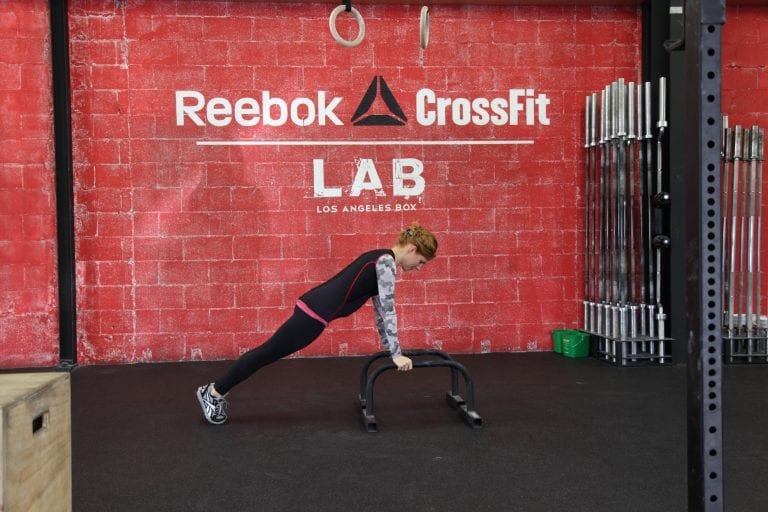You’ve seen pregnant women pushing the bounds of exercise safety via CrossFit.
Everyone naturally asks—is CrossFit safe? The general rule for exercise during pregnancy is, assuming you have your healthcare provider’s approval and you’re not considered high-risk, you can typically continue most fitness activities you did prior to pregnancy—but at a moderate level.
The biggest challenge is determining what’s moderate for you. If you’ve been doing metabolic and anaerobic training, such as CrossFit, prior to pregnancy, you’ve likely been working out at such an extreme level that your “moderate” is much more intense than most women’s activities, even those who exercised prior to pregnancy. But fitness experts agree—unless you’ve been doing CrossFit prior to pregnancy, do not begin in pregnancy.
I’m now pregnant with my second child, and I dabbled in CrossFit prior to this pregnancy. I earned a CrossFit certification with my Reebok Master Trainer certification, but to really do CrossFit in pregnancy right I sought the advice of my colleague Yumi Lee, one of the owners of the Reebok CrossFit Lab in Los Angles. I’m in my second trimester, so Yumi took me through some of her recommended exercises for cross-fitters during pregnancy. Please pay particular attention to the modifications and always stop if something just doesn’t feel right or safe.
For all weighted exercises, choose a weight that allows you to work hard, but NOT one that makes you go breathless—moderation is mandatory in pregnancy. Throughout, except where noted, work up to 8-12 reps but never beyond moderation or at a capacity that leaves you breathless.
Upper Body
Modified Push-ups (Chest, Back & Triceps): In pregnancy, your baby bump becomes too intrusive for push-ups. Consider CrossFit parallettes instead. You can elevate yourself, protect your bump, and still take your elbows to a 90-degree angle for max range of motion. Remember to pull your navel (or think of your baby) closer to your spine, squeeze your butt, and pull your shoulders back and down. Allow your elbows to head out on the angle.
Hanging Tuck (Back, Shoulders, Core): Once you’re past 20 weeks, abdominal crunches are out of the question. The Hanging Tuck provides both core and upper body benefits. When your belly impedes your knees from coming straight up, angle them out (opening your hips) to make room for your bump! Keep your scapula engaged (pull your shoulder blades together without arching your back), pull your baby closer to your spine, and remember to inhale & exhale deeply. Take breaks as often as you need to.
Lower Body
Weighted Back Squat to Medicine Ball (Butt, Legs): Don’t squat more than 90 degrees in pregnancy as this puts too much pressure on your joints and can over-stretch your already relaxed ligaments. Be safe instead with a weighted ball underneath as a stopping point. Perform this exercise with or without the added weights on your shoulders, keeping your hands on your hips. Keep your chest lifted, shoulders down and away from your ears.
Swings & Sumo Deadlift High-Pull with a kettlebell (Butt, Legs, Core, Back, Shoulders): Both of these exercises are great for working the core & lower body. Modify by taking your legs wider, opening your hips for comfort and stability, and making room for baby. As you swing the kettlebell, keep your wrists straight, swing no higher than eye level, and drive from your hips. In your Sumo Deadlift, take your feet even wider (than in the swing), so you can really engage the hamstrings & glutes. Swing out a little before you row to avoid baby. Because you can do this with a kettlebell, it’s a good modification for Sumo Deadlift High Pulls, that are usually executed with a weighted bar. See how many swings or high pulls you can do in 30-45 seconds at a moderate level (not breathless).
Cardio
Cardio can sometimes be the trickiest part of moderating workouts in pregnancy. Sprinting is out of the question so try these 3 CrossFit options:
Rowing (Butt, Legs, Back): This cardio booster works your whole body. Begin with a flat back, drive with the legs first, then extend the hips, and finally row your arms back. On your way back in, arms lead and legs follow. Begin by rowing for 2 minutes at a time and gradually increase duration; but head’s up—eventually your bump will put an end to this activity in pregnancy.
Farmer’s Carry (Butt, Legs, Core): Squat down, with your chest up to pick up free weights or kettlebells. Then simply go for a walk with your shoulders down and baby hugged in towards your spine. Start by walking for 2-4 lengths of your gym space at a time and gradually increase your distance over time. Remember to breathe deeply!
Modified Burpees (Entire body!): CrossFit Burpees involve your chest hitting the floor so that is obviously out. Modify by using parallettes to elevate yourself and instead of jumping or walking the feet as in a traditional burpee, take your feet wide and angled out, so that your hips open to allow room for baby. You may or may not want to jump up at the end. If you do jump, remember to land softly on the balls of your feet first, before lowering your heels to reduce impact.
Keeping It Honest: Moderate Intensity
- Talk out loud: If you can’t talk, it’s too intense for pregnancy.
- Don’t get too hot: Dress in layers.
- Stay hydrated: Carry a water bottle with you always.
- Take breaks often: Listen to your body!
- Keep breathing: Never get breathless.






Comments are closed.